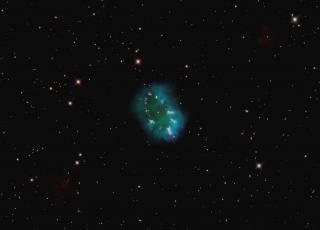Bibcode
Munari, U.; Corradi, R. L. M.; Siviero, A.; Baldinelli, L.; Maitan, A.
Bibliographical reference
Astronomy and Astrophysics, Volume 558, id.A2, 7 pp.
Advertised on:
10
2013
Journal
Citations
8
Refereed citations
6
Description
We report the discovery of a planetary nebula centered on the poorly
studied symbiotic binary star DT Ser. In a few other symbiotic stars
spatially resolved nebulae have been discovered as well, but only one of
them probably is a genuine planetary nebula, while the others are likely
to originate in complex mass-ejection episodes from the interacting
binary central stars that are possibly related to nova-like outbursts.
The rim of the planetary nebula around DT Ser is severely distorted
toward a brighter star 5 arcsec away. In infrared WISE data, this star
shows the presence of a detached cold-dust shell similar to those
observed in post-AGB stars. The apparent association of the symbiotic
star and its planetary nebula with the nearby possible post-AGB object
is discussed. We also discuss the sparse and conflicting literature data
that could support an observed variability of the surface brightness of
the planetary nebula. The puzzling and intriguing characteristics
displayed by DT Ser are surely worth additional and more detailed
investigations.
Related projects

Bipolar Nebulae
This project has three major objectives: 1) To determine the physico-chemical characteristics of bipolar planetary nebulae and symbiotic nebulae, to help understanding the origin of bipolarity and to test theoretical models, mainly models with binary central stars, aimed at explaining the observed morphology and kinematics. 2) To study the low
Antonio
Mampaso Recio